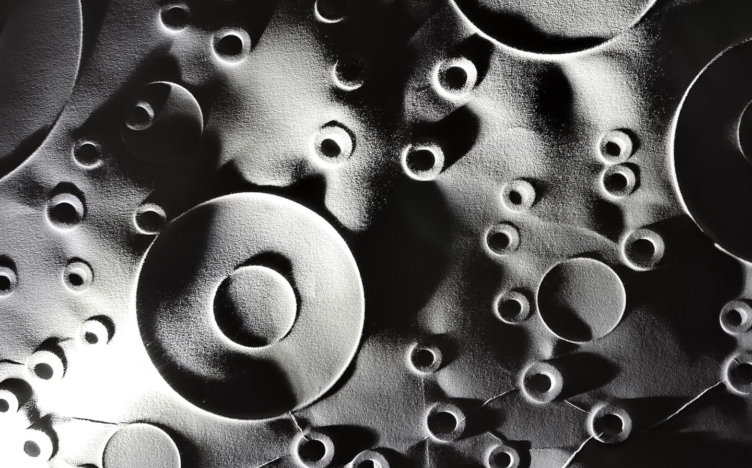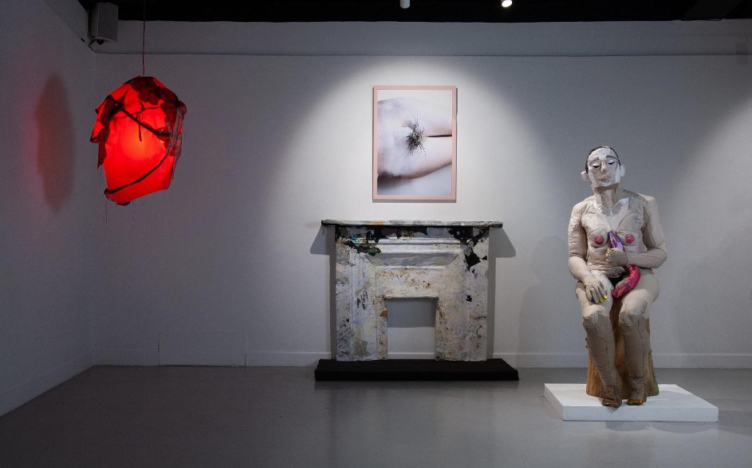01/10/2020 - 01/06/2021
Catriona Leahy’s work engages in sites wherein a particular dissonance manifests itself temporally, spatially or aesthetically, where anachronistic objects, architecture or particular landscape tropes usher the past into focus with the present. To that end, her interest lies in the remains of cultural phenomena that have been displaced, or have lost their significance in our “progress-driven”, globalised society. Residues on the landscape of our industrial past and by extension, the impact this human intervention has had on our environment also provide material for investigating the repercussions of a society driven by progress. Through a process of intervention in the image using print, photography, moving image, installation and sculpture, attention is drawn to transformations, latent aspects and layered histories.
More recent work has been preoccupied with the question of how to reimagine the landscape in a time of ecological crisis and considers the politics of land use. Here, the work often focusses on anthropogenic landscapes – landscapes made or transformed by man’s intervention. Processes of extraction, often violent in their assault on the landscape, are a point of focus as well as the imagined future and latent consequences of such actions. Derived from the Dutch word Landschap, landscape by its very definition acknowledges the shaping of the land by people. In an ever-evolving landscape, it is only much later that the repercussions of human intervention can be truly determined. The latency of a visual manifestation of such activities, teaches us that the consequences of our actions in one moment can have any number of outcomes – undetermined and unpredictable. It is this temporal latency that is of concern for Catriona – the ripples or tremors that are experienced or perceived, only much later after the event, as traces that meld into the fabric of our present.

Text piece laid down with soil from my family farm using specially laser-cut stencils. This work was selected and made specifically for Artworks Open, Encountering the Land, 2018, Visual Centre for Contemporary Art, Carlow.
The phrase “After A Gatherer Comes A Scatterer” has its origins in the Bible. In this context the phrase refers to words I have often heard used in rural contexts to describe a generation’s failure to cultivate and maintain the land. Witnessing my uncle utter these words to my father (a farmer), they embody an antagonistic tone. However, my uncle, himself a scattered immigrant in the UK exposes the tension in the phrase. In his utterance, his own bitterness and anxiety are projected onto the land that could not sustain him. More generally the phrase exposes the complexities and hardships inherent in kinship and rural life. It points to the difficulties faced by farmers today in maintaining a livelihood in increasing industrialised, technologically driven farming methods.

Digital Print mounted on fabricated folded cold-rolled steel and curved hot-rolled steel. This work was created during a 3-month residency at FLACC Workplace for Visual Artists in Genk, Belgium. It responds to the anthropogenic landscape of Genk. During my time there I looked to recent industrial past and how the mining heritage continues to impact Genk’s landscape. What remains of this industrial heartland provided a contextual backdrop for the work. The reshaping of the landscape extended far beyond Genk. In order to facilitate the transport of coal, the Albert Canal was constructed From 1930 through to 1939 to connect Antwerp with Liege. Its construction resulted in the cutting of the famous natural landmark, Mount Saint Peter, in two. Here, I mirror and dislocate the plane on which the image rests so that the image becomes fragmented, both static and dynamic. The intervention is emphasised all the more as the viewers’ movement back and forth causes the image to split and overlap. This fragmentation is characteristic of anthropogenic landscapes.

Photography (darkroom photography and photogram processes, exposed collaged negatives). The production of this work was supported by Arts Council Ireland Visual Arts Bursary 2018. It was produced for the exhibition How the land lies at Sirius Arts Centre Cork (currently on show January 2020 – end April 2020).
http://www.siriusartscentre.ie/visual-art/how-the-land-lies
Guided by the question of how to re-imagine landscape in a time of ecological crisis the deliberately fragmented images in this series Faultlines, created through the manipulation and collaging of photographic negatives, explores landscapes that are deemed redundant and subsequently repurposed for economic and ideological purposes. Photographs are taken on 120mm B/W film using a medium format camera. The negatives are subsequently cut and collaged back together again such that the landscape appears fragmented and dislocated. The sellotape’s edges are literally exposed to reveal what look like cracks, fissures or ruptures in the landscape.
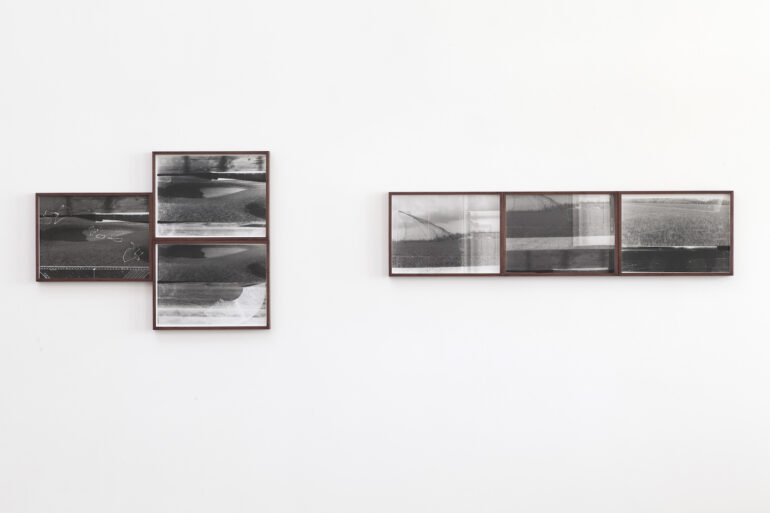


Folded Paper with digital print. This work was created during a 3-month residency at FLACC Workplace for Visual Artists in Genk, Belgium. It responds to the anthropogenic landscape of Genk - During my time there I looked to the lasting impact of the recent industrial past, and the legacy the mining heritage had and continues to have on Genk’s landscape. What remains of this industrial heartland provided a contextual backdrop for the work. The mining impact made a lasting impression on the contours of the landscape, manifested most obviously as spoil heaps or slag heaps. These sudden obtrusions appeared incongruous against the otherwise flat homogeneous landscape and represented for me a rupture not only geographically but temporally - the speed of their emergence in the landscape against the incomprehensibly slow formation of coal over millions of years. They are the anthropogenic scars borne from decades of human intervention. Working from a series of old photographs appropriated from the collection of photography at the Emile Van Doren Museum in Genk I set about a process of intervention on the images, in a sense excavating not the landscape but the image itself to reveal something of its content and history. Cracks and fissures as a result of the crumpled paper, represent what I like to interpret as light leaks or lacunae - spaces or gaps in the landscape that reveal traces of the past or a hidden potential future. They mimic the compressed, pressurized landscape as well as its fragmented appearance – an inherent feature of anthropogenic landscapes. The work was exhibited in Cmine Cultural Centre, Genk in 2014.
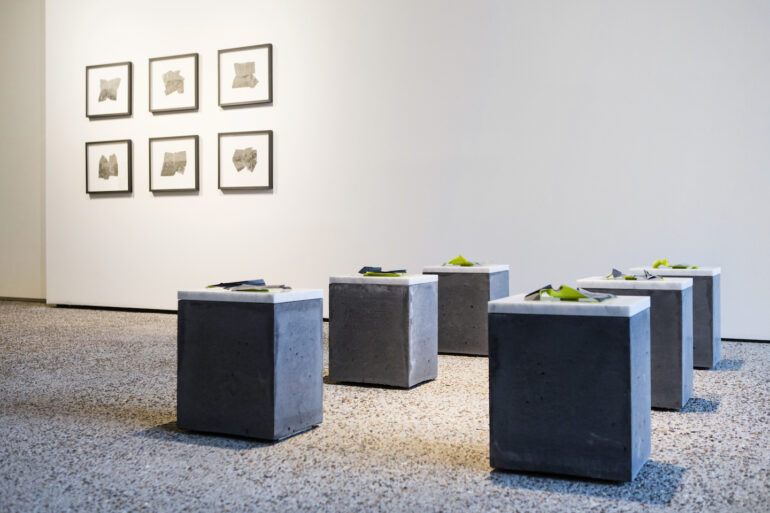
Cast Concrete and Marble.
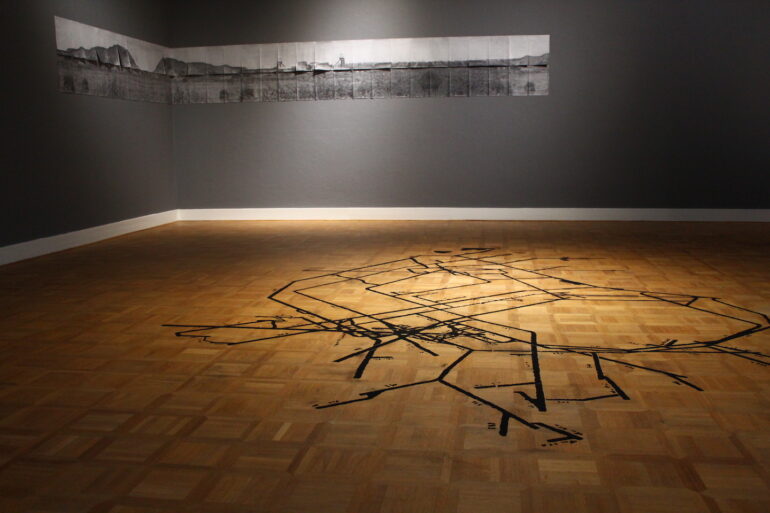
Rhizome is made with coal dust laid down with stencils. This piece was originally made specifically for the Rijksmuseum Twenthe in Enshcede, The Netherlands in 2015. It is reinstalled here in CCA Derry~Londonderry for the exhibition Fast Slow Fast in 2019. The piece is a to-scale map of the underground redundant coal mine tunnels at Cmine in Genk, Belgium.
Palindrome is a digital print on shiohara Japanese paper, composed of individual digital prints on shiohara Japanese paper. Palindrome takes an old panoramic photograph of the Walsal (UK) mining landscape as its point of departure. Part of a body of work responding to anthropogenic landscapes – man-made landscapes most evident in areas mined for their finite resources. A subtle intervention of doubling and mirroring of the image, suggests the unrelenting repetition of the daily grind of the miners, however, its incapacity to complete that loop in this particular instance, reminds us of the finite nature of this non-renewable resource.
This work was exhibited at the Rijksmuseum Twenthe in Enschede, The Netherlands in 2015 as part of an International Printmaking symposium that explored how contemporary artists use the medium in an expanded way. It was subsequently exhibited at De Cacaofabriek in Helmond, The Netherlands in 2018 as part of the exhibition “Unfolding Landscape”.
Catriona Leahy
Catriona Leahy is an artist based at Temple Bar Gallery & Studios where she holds a 3-year studio membership (2018-2021). She is also member of the Board of Directors at TBG&S. Catriona received her MA in Print from Royal College of Art, London in 2013 during which time she was awarded two study bursaries. She has exhibited both nationally and internationally. Recent exhibitions include How the land lies at Sirius Arts Centre, Cork (2020); Fast Slow Fast CCA Derry~Londonderry (2019); Unfolding Landscapes at De Cacaofabriek in Helmond, The Netherlands (2018); Coup de Ville, 3rd International Triennial Exhibition in Sint-Niklaas, Belgium (2016); Relief in Time, Rijksmuseum Twenthe Enschede, The Netherlands (2015). She is currently working towards a group exhibition, Agitation Co-op, in December 2020 at Temple Bar Gallery & Studios, with artists Michele Horrigan (IRE), Laurie Robins (UK/IRE) and Libita Sibungu (UK), curated by Michael Hill.
Recent awards include Arts Council of Ireland Visual Arts Bursary (2018), Culture Ireland Award (2018, 2016, 2011), Arts Council England Grants for the Arts (2016), AN Artist Bursary UK (2016). She has been the recipient of numerous international residencies such as The Frans Masereel Centre (2015, 2014, 2009), FLACC Workplace for Visual Artists (2014) - both in Belgium, Kloster-Bentlage near Munster, Germany and The Florence Trust in London (2015 – 2016).

